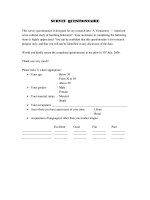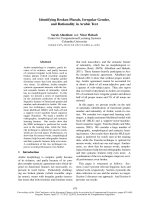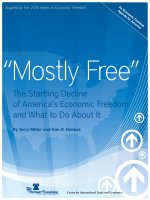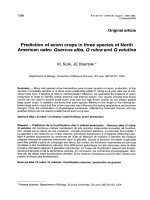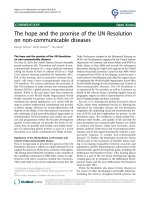AMERICAN TNCs: BROKEN PROMISE OF FREEDOM AND EQUALITY OF OPPORTUNITY
Bạn đang xem bản rút gọn của tài liệu. Xem và tải ngay bản đầy đủ của tài liệu tại đây (428.23 KB, 63 trang )
VIETNAM NATIONAL UNIVERSITY, HANOI
UNIVERSITY OF LANGUAGES AND INTERNATIONAL STUDIES
FACULTY OF ENGLISH LANGUAGE TEACHER EDUCATION
GRADUATION PAPER
AMERICAN TNCs: BROKEN PROMISE OF
FREEDOM AND EQUALITY OF OPPORTUNITY
Student: Nguyễn Tuấn Anh
Course: QH2010.F1.E16
HÀ NỘI - 2014
VIETNAM NATIONAL UNIVERSITY, HANOI
UNIVERSITY OF LANGUAGES AND INTERNATIONAL STUDIES
FACULTY OF ENGLISH LANGUAGE TEACHER EDUCATION
GRADUATION PAPER
AMERICAN TNCs: BROKEN PROMISE OF
FREEDOM AND EQUALITY OF OPPORTUNITY
Supervisor: Nguyễn Lê Hường (M.A)
Student: Nguyễn Tuấn Anh
Course: QH2010.F1.E16
HÀ NỘI – 2014
ACCEPTANCE
I hereby state that I, Nguyen Tuan Anh, being a candidate for the degree of
Bachelor of Arts (English – International Business) accept the requirements of the
College relating to the retention and use of Bachelor‘s Graduation Paper deposited in the
library.
In terms of these conditions, I agree that the origin of my paper deposited in the
library should be accessible for the purposes of study and research, in accordance with
the normal conditions established by the librarian for the care, loan or reproduction of
the paper.
Signature
Date
ACKNOWLEDGMENTS
i
First and foremost, I would like to express my deepest gratitude to Ms. Nguyen Le
Huong, MA, my supervisor, who has supported me in choosing this topic and
supervised my work carefully. Her proper and critical guides as well as valuable
encouragements during the research process were the most solid support for the
complete study. Without her enthusiastic instruction, I will not fully complete my
research as desired.
In addition, I am genuinely grateful to Dr. Nguyen Kim Anh, my lecturer in
International Investment course. Thanks to her substantial help, I could gain useful
materials for the research.
Lastly, I want to sincerely say thanks to my beloved family and friends with their
warm and prompt encouragements and help to finish my research on the right tract.
ABSTRACT
ii
As economic development has become the leading objective of each nation in
the world, human care has been gradually faded in order to fulfill that goal. The
existence and growth of transnational corporations (TNCs), especially American
TNCs has further highlighted that tendency while the USA is often described as
destination for freedom and equality. Therefore, this research investigates American
TNCs’ respect for freedom and equal opportunity in terms of their labor treatments
and expansion strategies when they operate their affiliates abroad.
Secondary approach with documentary and contextual analysis of observed
phenomenon and case study are intensively used to study about American TNCs’
activities, the co-ordination between their operation and code of conduct in business
through detailed contexts.
Results of the study prove the link between the expansions of cross-border
capitalism and broken promise for better practice of worker and human rights. In
particular, burgeoning penetration of American TNCs has threatened host countries’
territorial sovereignty. Furthermore, under the pressure of cutting cost, American
TNCs have exploited cheap labor force, and have implemented irrelevant wage levels,
poor employees’ benefits and have offered inadequate training and promotion. They
also create unequal competition in the interaction with local firms to maintain their
monopoly.
LIST OF TABLES AND FIGURES
iii
LIST OF TABLES PAGE
Table 1 10
Table 2 15
Table 3 16
LIST OF FIGURES PAGE
Figure 1 9
Figure 2 13
TABLE OF CONTENTS
Acknowledgments i
iv
Abstract ii
List of tables and figures iii
Page
Chapter 1: Introduction
1.1.Statement of problem & rationale for the study 1
1.2.Statement of research questions 3
1.3.Research goals and objectives 3
1.4.Scope of the study 4
1.5.Significance of the study 5
1.6.Design of the study 5
Chapter 2: Literature review
2.1. Definition and classification of international investment 7
2.1.1. Definition 7
2.1.2. Classification of international investment 8
2.2. Definition of TNCs and their forms of investment 8
2.2.1. Definition 8
2.2.2. Forms of TNCs 8
2.3.Establishment of TNCs – the spread of transnational capitalism 9
2.3.1Motivations of companies reaching a certain size to become TNCs 9
2.3.2. Traditional values that drive American TNCs’ growth 11
2.4. A brief history of TNCs & American TNCs’ development 13
2.4.1.From origins to World War II 13
v
2.4.2.From 1945 – to present 15
2.5. Roles of TNC in global economy and social development 17
2.5.1.Economic and social achievements brought to host country 17
2.5.2. Economic and social achievements brought to the whole world 18
Chapter 3: Methodology 20
Chapter 4: TNCs and national sovereignty
4.1.Territorial penetration 22
4.2.Interferences into local state’s economic system 23
4.2.1.Financial dependence 23
4.2.2. Interference with balance of payment 25
4.3.Political intervention 26
4.4.Integrated cultures 30
Chapter 5: TNCs and Employment issues
5.1. Human resources management issues 33
5.1.1.Labor exploitation 33
5.1.2.Worker’s Trade Union rights 35
5.1.3.Attacks on physical integrity 36
5.2. Wage levels and employee benefits 38
5.2.1.Unequal payment 38
5.2.2.Massive home worker lay-offs 39
5.2.3.Workforce training and promotion opportunity 40
vi
5.3. Working conditions and employees’ health and safety 41
Chapter 6: TNCs and Competition 43
Chapter 7: Conclusions, implications, limitations and suggestions
7.1. Conclusions and implications 45
7.2. Limitations of the study and suggestions for further studies 47
References 48
Appendices 53
vii
CHAPTER 1: INTRODUCTION
1.1. Statement of problem & rationale for the study
It is obvious that all nations and territories over the globe have an excessive
demand for development. The “growth-centered” tendencies with the principal focus
on economic objectives have undeniably brought countries great benefits. However,
the over-concentration on economic achievements for many years has now revealed
its back-sides on the society.
“Growth-centered economic policies accelerate the breakdown of the earth's
regenerative systems, and intensify the competition between rich and poor for the
earth's remaining real wealth. The result is a three-fold human crisis of increasing
poverty, environmental destruction, and social disintegration” (David C. Kotern,
1990).
Needless to say, humans are the most vital factor regulating the destiny of our
whole planet. Therefore, people development should be constantly invested in the
most comprehensive way, as it will ensure the sustainable existence of our earth.
Nonetheless, the force of globalization and external competition has reinforced
economic “growth-centered” policies. This unbalance has significantly triggered a
neglect of care to humans.
Nowadays, international investments have strengthened not only the prosperity
of participating countries but the growth of the whole world as well. Trans-national
1
corporations (TNCs) with their FDI outflows have obtained greatest achievements,
profits and success in the global market. They also brought host countries a great
number of jobs, advanced technologies, modern facilities, management skills, etc.
The United States, one of the most powerful and wealthy nations in the world,
has never forgotten to protect human rights and humanitarianism. It is often proud of
its values and beliefs in a democratic society “A land of freedom and opportunity”
(Jane Morse, 2010). Furthermore, America’s “people-concentrated” policies in
foreign investment and human resources management, which emphasize values of
freedom and equality of opportunity, are often praised to be equal and ideal. However,
have American TNCs broken their accountability commitments? In other words, is the
principle of people development really applied despite the high-pressure upon the
growth-centered polices to recover from the recent economic crisis? Those questions
stimulate the curiosity of the writer. As a result, this research paper named “American
TNCs: broken promise of freedom and equality of opportunities” was conducted.
The researcher expects that readers can gain more profound understanding of
American traditional values that drive TNCs’ cross-border expansion, and then get a
clearer overview of American TNCs’ offshore investment activities and policies.
Moreover, readers will be able to evaluate American TNCs’ human rights promises
and their role as leader in “people–centered” development. With this paper, the writer
wishes to make his own contribution to the development of humanistic issues as well
2
as rights of local workforces in developing countries, especially, Vietnam, which has
received great amounts of FDI inflows from American TNCs.
1.2. Statement of research questions
In order to interpret American TNCs’ respect for freedom and equality of
opportunity, the researcher will concentrate on two main research questions:
1) What are the fundamental values driving American TNCs’ development and
foreign expansion?
2) To what extent have American TNCs violated their values of freedom and
equality of opportunity as their human-rights commitment?
1.3. Research goals or objectives
As stated, the US is usually considered to play the flagship role in protecting
human rights. At the federal level, the U.S. Commission on Human Rights is put in
charge of, and at the national level, the Montgomery County Office of Human Rights
is dedicated to promoting human rights. Even, at the municipal level, the City of
Rockville set up its own Human Rights Commission (David J. Smith & Rockville,
2010).
However, the pressure of the economic crisis has urged the US to pay special
attention to economic growth in order to recover. The researcher, therefore, has great
concerns about whether human rights are highly respected or not. Hence, the primary
aim of this research paper is to analyze the American TNCs’ foreign investment
activities and policies to see if they violate their values of freedom and equality of
opportunity. Accordingly, the American TNCs’ broken promise of human rights will
be clarified.
3
In addition, the researcher provides some implications for host countries to employ
effective foreign investment policies towards the American FDI inflows so as to
protect the rights for local workers. All of these are expected to support the trend of
“people-centered” policies for sustainable development and a crucial need to raise
human rights, which attract great attention from nations, regions, groups and
organizations.
1.4. Scope of study
The research is aimed at observing how American TNCs fulfill their human
rights commitment for freedom and equal opportunity. Hence, comparisons and
contrasts on different viewpoints of American TNCs’ operations and employment
policies will be collected to clarify the research topic. American TNCs would be
mainly investigated in the last five decades when those corporations grew rapidly and
conducted unethical activities to serve their cross-border expansion. The research
topic is a very sensitive and debating issue, as economists tend to encourage TNCs’
capitalism to target economic goals, while socialists do not, because their aim is to
attain development stability. In this study, American TNCs’ activities will be more
comprehensively analyzed from the viewpoints of socialists to highlight their respect
or disrespect for human rights.
1.5. Significance of the study
4
With this research, readers will be provided with a more profound overview of
American traditional values as well as TNCs’ concepts, which is useful in both social
and economic related fields. Furthermore, readers will become aware of our emerging
global trend - “sustainable development with high respect for human rights”. As a
result, “American TNCs: broken promise of freedom and equality of opportunity”
firstly proves to be of great help for both teachers and students ,especially those who
specialize in fields of social studies (including American studies, International
Relations and International studies), foreign investment as well as other related
economic studies such as international business and foreign trade. Besides, it will be a
necessary source of references for others who have intentions of conducting a
research in the same field or related topics.
Being a student of the double-major (English – International Business) program,
which is brand-new at ULIS - VNU, the researcher hopes that his study will
contribute to the useful reference resources of double-major teachers and students as
well as the development of this program .
Finally, this research paper is helpful for readers to raise their awareness of human
rights protection in Vietnam, especially when Vietnam was elected as a member of
United Nation Human Rights Council for 2014-2016 tenure by 184 among 192
nations on 12 November 2013.
1.6. Design of the study
Chapter 1 - Introduction
This chapter presents the rationale, the research questions, the aim and objectives, the
scope and the significance of the study.
Chapter 2 - Literature Review
5
Chapter 2 offers theoretical backgrounds such as international investment matters,
concept of TNCs, and traditional values that drive TNCs to conduct their offshore
investments.
Chapter 3 - Methodology
This chapter deals with methods of collecting and analyzing data to carry out the
research.
Chapter 4 - TNCs and national sovereignty
Chapter 4 illustrates faded power of host governments on national border, economic
system, political issues and cultural aspects when American TNCs’ affiliates
participate in local economy.
Chapter 5: TNCs and unemployment
This chapter clarifies TNCs’ commitment to workplace health and safety, their
practices in worker training and promotion opportunities, and their policies of
industrial relations and democracy.
Chapter 6 - TNCs and competition
Chapter 6 focuses on analyzing TNCs’ involvement in unequal competition in local
market as well as fraud and artificial competition.
Chapter 7 – Conclusions, Implications, limitations, and suggestions.
6
CHAPTER 2: LITERATURE REVIEW
Foreign direct investment (FDI) serves as an engine for growth and prosperity. It
involves both ownership and control of the foreign entity by the Transnational
Corporations (TNCs) (Kavaljit, 2007). Thus, the intensive emergence of TNCs
quickly accelerates the total FDI flows in the world.
This chapter brings readers an overview of matters in international investment and
concepts of TNCs including definitions, forms, roles, establishment and development
history as well as motivation and traditional values that drive TNCs to expand their
capitalism by investing abroad. This chapter plays an important role to the whole
thesis as the theoretical background to analyze American TNCs’ activities and
policies with regard to their respect for freedom and equality of opportunity.
2.1. Definition and classification of international investment
2.1.1. Definition
“Investment is the use of an amount of assets such as capital, technology, and so
on in a specific economic activity to create one or several products for society in
order to gain profit. In addition, international investment is defined as a cross-border
transfer by investors of tangible or intangible assets in terms of capital, technology,
management skills etc to run business so as to earn high profit on global scale.”
(Phung, 2001: p.7).
The definition reflects the most distinctive characteristic of TNCs in term of cross-
border capitalism. In order to spread this economic power, TNCs conduct their
investment abroad by transferring assets such as capital, technology etc. Accordingly,
two most major features distinguishing TNCs’ international investment with other
financial activities include “profit” and “risk”.
2.1.2. Classification of international investment
7
International investment is conventionally divided into 2 main groups: Foreign
Domestic Investment (FDI) and Foreign Portfolio Investment (FPI): FDI is a real
investment in factories, capital goods, land and inventories. Hence, both capital and
management are involved for medium and long-terms. Meanwhile, FPI requires the
development of stock and bond markets in other countries because it includes
purchases and sales of securities (bonds and stocks). FPI exists when investors own an
amount of securities that is not big enough to make any direct management or
influence on the bonds or stocks issuing (Kavaljit Singh, 2007: p15-16)
2.2. Definition of TNCs and their forms of investment
2.2.1 Definition
John Dunning (1992) defines a transnational corporation as “an enterprise that
engages in FDI and owns or controls value-adding activities in more than one
country”.
In such a way, TNCs undertake cross-border investment activities or FDI. Thus
their operating assets are not restricted within only one country. Their products are
manufactured outside of their country and engage in international consumption.
2.2.2 Forms of TNCs
Forms of TNCs’ subsidiaries in host countries are classified based on three main
criteria including investment goals (Vertical investment and Horizontal investment),
investment strategy-base (Greenfield investment and Merger & Acquisition) and
ownership-base (100% foreign owner center and joint venture) (Phung, 2001:p15-21)
(See Appendix 3).
TNCs conduct their different forms of foreign investment with their own specific
goals. TNCs sometimes choose vertical investment to make use of host countries’
abundant natural resources or horizontal investment to avoid high tariff or joint
8
venture to reduce risks. If these goals solely focus on profits, they will closely link to
their respect to freedom and equality of opportunity (See Appendix 3).
2.3. Establishment of TNCs – the spread of transnational capitalism
2.3.1. Motivations of companies reaching a certain size to become TNCs
On the whole, before setting up affiliates outside home country, American
business enterprises maintain a medium and small model of operation with modest
capitalism. Therefore, their markets are still narrow, offering fewer chances of access
to international distribution market. However, they become TNCs undertaking FDI
activities when their capital accumulation grows quickly.
From the viewpoint of microeconomics, TNCs’ FDI expansion embarks on
numerous reasons such as seeking a more favorable environment, diversifying
consumption from external market, host countries’ commitment of significant
resources for new products and processes and protecting their market share
(Dunning,1988). (See Appendix 1)
With regards to macroeconomics-based theories, the chief reason for TNCs
undertaking FDI is to maximize profits on a global scale by means of effective
investment. The home country, which owns redundant funds, often has less efficiency
of using capital than a host country with insufficient funds. Therefore, the gap
between the efficiency of using capital stimulates the FDI inflows and outflows.
9
Nation I Nation II
Figure 1: Mac Dougall-Kemp Model (Phung, 2001: p.46-47)
+ Before capital mobility: GDP of Country I: FGAO; GDP of Country II: JMAO’
+ After capital mobility: (capitals equivalent to AB moving from Country I to
Country II)
Country I Country II
New capitals = NRAO Return on
capitals gains NRGC
New capitals = TRAO’ Returns on
capitals loses MHTR
New Jobs = FEN Jobs lose NEGC New Jobs = JET Jobs lose MHTE
GDP gain ERG GDP gain MER
GDP of the whole world: gain ERG+MER = MEG
Table 1: (Phung ,2001: p.46-47)
Undeniably, the existence of TNCs and FDI firstly brings the home country more
rates of return on capitals while bringing host countries more jobs to increase local
incomes. Secondly, the GDP of the whole world will also increase resulting from the
GDP growth of each nation in the international market.
10
F
N
C
O
E
M
J
H
B
A
T
O
’
G
R
Jere Behrman, on the other hand, demonstrates 4 different objectives of FDI
which stimulate TNCs to penetrate foreign investment environment including:
resource seeking FDI, market seeking FDI, efficiency seeking FDI , strategic asset
and capitabilities seeking FDI (Phung, 2001: p.63). (See Appendix 2)
2.3.2 Traditional values that drive American TNCs’ growth
Cultural factor plays an important role in doing international business in general
and international investment in particular. Each investor brings his or her own
traditional beliefs and values when undertaking foreign investment in host countries.
Therefore, foreign culture awareness and integration should be raised. Some
traditional values driving American TNCs’ growth can be listed below.
The first value to be mentioned is mobility. For Americans, mobility has been seen
as a practical solution to a problem. If you want a new life, a good way is to move
and make a fresh start. This embracement of mobility is deeply rooted in the fact that
American has always been a country of immigrants (Crandall, Maryanne Kearny &
Edward Kearny, 2004).
Following the American tradition of mobility, TNCs may primarily initiate cross-
border mobility in order to achieve their specific organizational goals: more favorable
environment, seeking for abundant natural resources and gaining more profits.
The second traditional value that has driven TNCs’ growth is progress, the desire
to move forward by making use of any opportunities that come into sight. The desire
of success and progress clearly encourages American TNCs to employ host countries’
workforce and natural resources for growth. They have grabbed the opportunities
brought about by globalization to make other countries’ natural and human resources
work for their own benefits (Crandall, Maryanne Kearny & Edward Kearny, 2004).
The third value that stimulates cross-border capitalism of TNCs is self-reliance.
Self-reliance reflects individual’s independence and self-control over any
11
circumstances. Americans express respect to successful persons whose great
achievements are gained from his/her enormous efforts (Crandall, Maryanne Kearny
& Edward N. Kearny, 2004).
That spirit of independence and self-control prompts American TNCs to survive
without asking for much government support. Owing to the fact that domestic market
is dense of identical products, American TNCs spread their capitalism abroad to be
more powerful by widening their distribution network. Moreover, they enter foreign
market with the hope of seeking new favorable inputs without depending on domestic
suppliers.
Fourthly, competition is one of the most influencing values that motivate
American TNCs to widen their power abroad. Life is always a race and a person
cannot stop competing to survive and succeed (Bradley Lands, 2011).
As stated, the domestic market is full of strong rivals, so each corporation must
compete to survive. However, domestic supporting industry has limited capacity,
proving that all corporations cannot be well supplied with abundant input (raw
materials, spare parts, etc.) internally. Thus, American TNCs conduct international
investments to mobilize external sources serving their ambition for growth &
prosperity.
Finally, pragmatism (material wealth), hard work and achievement play an
important role in driving American TNCs to boost FDI: “Pragmatism (material
wealth) refers to the pursuit of wealth and comfort” (Robin Williams, 1970). Despite
being considered as a tradition or habit in numerous countries, hard work proves to be
a spirit in the US. The Americans often bear in mind competitive spirit motivating
them to work harder to get progress. Besides, Americans always recognize one’s
success in comparison with his or her power, status, wealth and property.
Achievement, therefore, is defined as an appropriate measure of one’s success. “The
12
great American Dream of fame and fortune comes to those who work hard and never
give up (L. Robert Kohls, 1984)”.
Pragmatism, hard work and achievement involve the expansion of American
TNCs outside the country border. The dream of getting richer and more successful is
highly appreciated in the US. For Americans, the most objective measure of success is
material wealth and achievement. Therefore, capitalism is reinforced by American
TNCs’ FDI outflows in potential invested regions, especially, developing or emerging
countries with abundant natural resources.
2.4. A brief history of TNCs & American TNCs’ development
2.4.1. From origins to World War II
The first businesses to make international investment include colonializing and
imperialist ventures from Western European countries like England and Holland.
State support was provided to the colonial trading system in as early as the 16
th
century (Kavaljit Singh, 2007: 15).
During the 19
th
century, British-based firms in the colonies of the British Empire
started to make considerable foreign investments, and the advent of industrial
capitalism gave birth to the first TNCs. The search for natural resources during the
19
th
and 20
th
century further motivated foreign operations by the US and Western
Europe-based firms (Kavaljit Singh, 2007: 16).
In the period of pre-1914, foreign investment became a trend with intensive
capitals. The capital of the UK made up more than a half of the total capital inflow in
the world, being “the largest creditor nation”. However, Europe became a net debtor
in 1920s because of World War I reconstruction cost, which left the net creditor status
of Europe in the hand of the USA (Kavaljit Singh, 2007: P.20-21).
The following chart collects the percentage of FDI from American TNCs relative
to its GDP from 1923 to1998. It’s noticeable that FDI of American TNCs is quite
13
intensive and dynamic with the highest point of 2% of GDP during the period from
1923-1928 despite obtaining a slight downward trend from 1928 to 1930. However,
FDI keeps increasing since the 1930s (Figure 2 below).
During the period from the origin to World War II, developed countries, mostly in
Central and Eastern Europe were destinations of American TNCs’ capital inflows,
known as “South – North” trend. Therefore, developed countries received most of the
global FDI inflows at that time.
In order to clarify that trend, product life-cycle theory by Raymond Vernon
illustrates that local people in developed countries are first provided with new
products because those nations have big capital sources and break-through
technology. After that, new products are exported to countries whose needs, tastes and
incomes are alike. Therefore, almost all of new products appear in advanced nations.
In order to reduce the cost of production, copy product is produced abroad
(developing countries with abundant natural resources), and then supplied in the home
country to capture growth in home market (Phung, 2001:p.56). That theory
emphasizes that developed countries become destinations of FDI from American
TNCs because of their technological advances to receive technology transfers. In
14
addition, same market size, equivalent purchase power, and liberalization policy are
also encouraging factors to American TNCs.
2.4.2. From 1945 – to present
After World War II, the US became a major creditor with very rapid development
and the “sole” nation having outward FDI soar. From 1948 to the end of 1960s, the
US had to face with strong European and international economic restrictions. In order
to handle that stiff situation, “Marshall Plan” and liberalization of national and
international trade and investment were adopted, so the US was facilitated to access
to foreign markets. Also, the US’ outward FDI was stimulated by its domestic tax
system (Kavaljit Singh, 2007: p.27).
The period of 1970s witnessed stronger monopoly enhancement of TNCs and their
increasingly important role in international trade than before and TNCs controlled 70-
80% of world trade. (Kavaljit Singh, 2007: p.27)
Since the mid-1980s, TNCs quickly emerged as core entity of FDI. In five years
from 1988 and 1993, worldwide FDI stocked almost doubled from US$1.1 to US$ 2.1
trillion, which was a reflection of TNCs’ increased productive capacity outside their
home countries (Kavaljit Singh, 2007: p.29)
By the beginning of the 21
st
century, the economic power of TNCs was reinforced
intensively. In 2000, FDI of TNCs hit the peak of more than $1.4 trillion but
decreased to $655 billion in 2003. However, FDI flows recovered in 2004 and
reached $955 billion in 2005. (Source: World Bank data).
In terms of outward FDI from American TNCs, US accounted for 85% of new
FDI flows from 1948 to 1965. FDI became the major component of foreign
investment in this period. US became the principal source nation. However, by the
1980s, Global FDI flow increased to over 500 billion USD, two-third located in
Europe and North America. In this period, we witnessed the rise of Japanese outward
15
FDI to US, Europe, and East Asia. Although FDI outflow of American TNCs still
made up the high percentages of the world, its speed tended to decrease giving the
way for the strong growth of Japanese and European FDI outflow illustrated in the
following chart:
Table 2: FDI outflows (period average, per percent of total)
In the period from 1945 to present, although FDI inflows into developed country
are still giant, American TNCs tend to spread their capitalism to developing countries
(South – South trend) in East Asia and Pacific region. Especially, flows to Central and
West Asia, China, and India have been recently expanded largely because of higher
oil investment. Nowadays, the USA no longer had abundant natural resources owing
to highly concentrated industrialization. Therefore, destinations of FDI flows from
American TNCs have now been developing countries or newly industrial countries
with pristine and rich natural resources such as Latin American countries (Mexico and
Brazil), Algeria, Angola, Libya, Mauritania, Nigeria, and South Africa concentrated
in the oil, gas, and mining sectors. Moreover, the development of technology and
16
